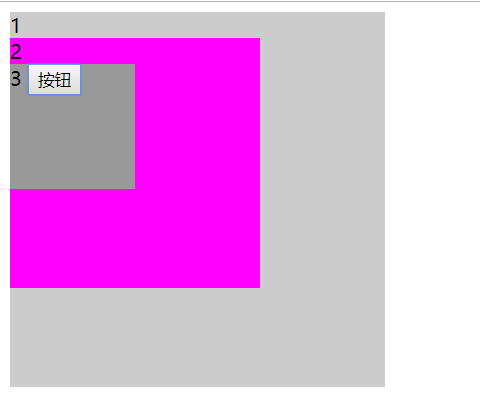
<body> <div id="first" style=" 300px;height: 300px;background-color: #ccc;">1 <div id="second" style=" 200px;height: 200px;background-color: #f0f;">2 <div id="third" style=" 100px;height: 100px;background-color: #999;">3 <button id="btn">按钮</button> </div> </div> </div> <script src="./jquery.min.js"></script> <script> var $btn = $('#btn') var $first = $('#first') var $second = $('#second') var $third = $('#third') // 通过传入最后一个参数的不同来确定执行捕获还是冒泡,false是绑定的冒泡,true是绑定的捕获 $btn[0].addEventListener("click", function(e){ console.log(3); }, true); $btn[0].addEventListener("click", function(e){ console.log(4); }, false); // 事件源本身的捕获还是冒泡的顺序是按书写的顺序来的,没有先后之分 $third[0].addEventListener("click", function(e){ console.log(5); }, false); $second[0].addEventListener("click", function(e){ console.log(6); }, false); $third[0].addEventListener("click", function(e){ console.log(2); }, true); $second[0].addEventListener("click", function(e){ console.log(1); }, true); </script> </body>
上边的打印结果是依次从1到6,执行的顺序是先执行捕获过程,再执行冒泡过程,捕获是在window开始一直到事件源,冒泡是从事件源开始到window,事件源的捕获和冒泡没有先后顺序之分,只是哪个先绑定哪个先执行
event.stopPropagation()起到阻止捕获和冒泡阶段中当前事件的进一步传播